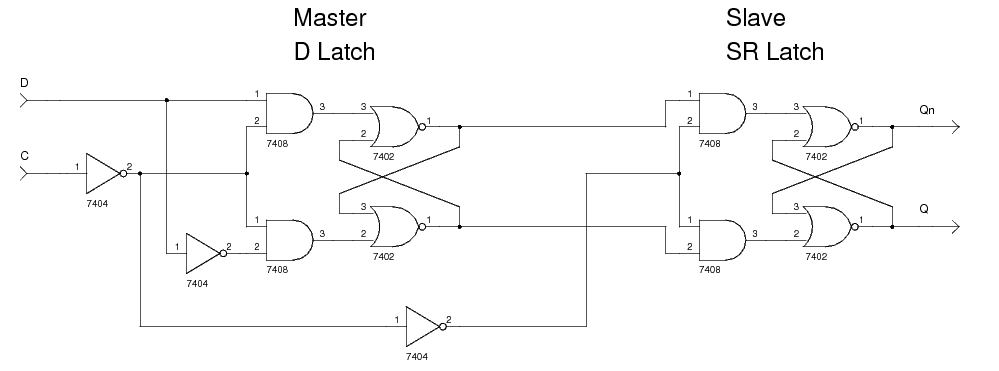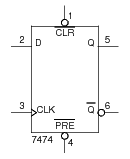D Flip-Flop (edge-triggered)
A D flip-flop is used in clocked sequential logic circuits to store one bit of data.
The D flip-flop described here is positive edge-triggered which means that the input which is stored is that input which is
seen when the input clock transitions from 0 to 1.
This flip-flop is built from two gated latches: one a master D latch, and the other a slave
SR latch.
The master takes the flip-flops inputs: D (data) and C (clock).
The clock input is inverted and fed to the D latch's gate input.
The slave takes the master's outputs as inputs (Q to S and Qn to R),
and the complement of the master's clock input.
The slave's outputs are the flip-flop's outputs.
This difference in clock inputs between the two latches disconnects them and
eliminates the transparency between the flip-flop's inputs and outputs.
The schematic below shows a positive edge-triggered D flip-flop.
The input D is used to set and reset the flip-flop's data.
The clock input C is used to control both the master and slave latches making sure only one of the latches can set its data at
any given time.
When C has the value 1, the slave can set its data and the master cannot.
When C has the value 0, the master can set its data and the slave cannot.
When C transitions from 0 to 1 the master has its outputs set which reflect the flip-flop's inputs when the
transition occurred.
The outputs Q and Qn are the flip-flop's stored data and the complement of the flip-flop's stored data respectively.

The schematic symbol for a 7474 edge-triggered D flip-flop is shown below. This chip has inputs to asynchronously clear and set the flip-flop's data.

Example
The following function table shows the operation of a D flip-flop. The column header Q(t+1) means
"the value of Q at the start of the next clock period", similarly for Qn(t+1).
D |
Q(t+1) |
Qn(t+1) |
Meaning |
|---|---|---|---|
0 | 0 | 1 | Reset |
1 | 1 | 0 | Set |
Verilog
Below is the Verilog code for a structural model of a positive edge-triggered D flip-flop. The code for the gated D and SR latches is also shown for completeness.
module d_flip_flop_edge_triggered(Q, Qn, C, D);
output Q;
output Qn;
input C;
input D;
wire Cn; // Control input to the D latch.
wire Cnn; // Control input to the SR latch.
wire DQ; // Output from the D latch, input to the gated SR latch.
wire DQn; // Output from the D latch, input to the gated SR latch.
not(Cn, C);
not(Cnn, Cn);
d_latch dl(DQ, DQn, Cn, D);
sr_latch_gated sr(Q, Qn, Cnn, DQ, DQn);
endmodule // d_flip_flop_edge_triggered
module d_latch(Q, Qn, G, D);
output Q;
output Qn;
input G;
input D;
wire Dn;
wire D1;
wire Dn1;
not(Dn, D);
and(D1, G, D);
and(Dn1, G, Dn);
nor(Qn, D1, Q);
nor(Q, Dn1, Qn);
endmodule // d_latch
module sr_latch_gated(Q, Qn, G, S, R);
output Q;
output Qn;
input G;
input S;
input R;
wire S1;
wire R1;
and(S1, G, S);
and(R1, G, R);
nor(Qn, S1, Q);
nor(Q, R1, Qn);
endmodule // sr_latch_gated
A simulation with test inputs gave the following wave form:

References
Kleitz, W. Digital Microprocessor Fundamentals. 3rd Edition. Prentice Hall, 2000.
Mano, M. Morris, and Kime, Charles R. Logic and Computer Design Fundamentals. 2nd Edition. Prentice Hall, 2000.